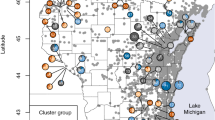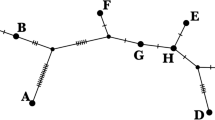Abstract
One of Mexico’s most emblematic and economically important plants is the poinsettia (Euphorbia pulcherrima). After nearly 200 years of poinsettia cultivation outside Mexico, more than 300 varieties of many different sizes, shapes and colors have been generated. However, studies on the management of or the evolutionary processes through which the changes present in cultivars have been generated, starting from wild plants, have not been carried out. In the present work, we tested the hypothesis that poinsettia plants living in human settlements represent transplanted wild plants. To test this hypothesis, we analyzed the genetic diversity and kin relationships of 58 poinsettia plants from 25 wild populations, 25 garden plants and 8 Mexican and foreign cultivars. Two non-coding intergenic chloroplast markers, trnG-trnS and psbA-trnH, were utilized to obtain the diversity indices and genealogies. The results support the transplanting of poinsettias hypothesis because garden plants share the same genetic variant as the wild populations and, in most cases, that of the closest wild populations. Some garden poinsettias have simple inflorescences, like the wild plants. The garden plants have a genetic diversity that is higher than in cultivars and that is shared with nearby wild populations. Additionally, some homeowners indicated that their plants were obtained from nearby hills. The transplanting of wild poinsettia plants to human settlements could have been one of the first steps in the domestication process of E. pulcherrima. Also, new genetic variants were found; one of these could be Euphorbia fastuosa, an invalid name for E. pulcherrima proposed by Sessé and Mociño between 1787 and 1803.



Similar content being viewed by others
References
Avise JC (2004) Molecular markers, natural history, and evolution. Sinauer Associates, Sunderland
Casas A, Caballero J, Mapes C, Zárate S (1997) Management of vegetation, plant domestication and origins of agricultura in Mesoamerica. Bot Sci 61:31–47. https://doi.org/10.17129/botsci.1537
Clement M, Posada D, Crandall KA (2000) TCS: a computer program to estimate gene genealogies. Mol Ecol 9:1657–1659
Darriba D, Taboada GL, Doallo R, Posada D (2012) jModeltest 2: more models, new heuristics and parallel computing. Nat Methods 9:772. https://doi.org/10.1038/nmeth.2109
Hamilton MB (1999) Tour primer for the amplification of chloroplast intergenic regions with intraspecific variation. Mol Ecol 8:513–525
Huelsenbeck JP, Ronquist F (2001) MrBayes inference and phylogenetic tres. Bioinformatics 17:754–755
Klotzsch J (1834) Beschreibung zweier neuer Euphorbien aus Mexico. Allg Gartenzeitung 2:27
Lack HW (2011) The discovery, naming and typification of Euphorbia pulcherrima (Euphorbiaceae). Willdenowia 41:301–309. https://doi.org/10.3372/wi.41.41212
Librado P, Rozas J (2009) DnaSP v5: a software for compressive analysis of DNA polymorphism data. Bioinformatics 25:1451–1452. https://doi.org/10.1093/bioinformatics/btp187
Mociño JM (2010) La Real Expedición Botánica a la Nueva España. UNAM, México
Parker KC, Trapnell DW, Hamrick JL, Hodgson WC, Parker AJ (2010) Inferring ancient Agave cultivation practices from contemporary genetic patterns. Mol Ecol 19:1622–1637. https://doi.org/10.1111/j.1365-294X.2010.04593.x
Pickersgill B (2007) Domestication of plants in the Americas: insights from mendelian and molecular genetics. Ann Bot 100:925–940. https://doi.org/10.1093/aob/mcm1932016
Sang T, Crawford DJ, Stuessy TF (1997) Chloroplast DNA phylogeny, reticulate evolution and biogeography of Paenoia (Paeoniaceae). Am J Bot 84:1120–1136
Steinmann VM, Porter JM (2002) Phylogenetic relationships in Euphorbiae (Euphorbiaceae) based on ITS and ndhF sequence data. Ann Missouri Bot Gard 89:453–490
Trejo L, Feria-Arroyo TP, Olsen KM, Eguiarte LE, Arroyo B, Gruhn JA, Olson ME (2012) Poinsettia’s wild ancestor in the Mexican dry tropics: historical, genetic, and evironmental evidence. Am J Bot 99:1146–1157. https://doi.org/10.3732/ajb.1200072
Trejo L, Rosell JA, Olson M (2018) Nearly 200 years of sustained selection have not overcome the leaf area-stem relationship in the poinsettia. Evol Appl 11:1401–1411. https://doi.org/10.1111/eva.12634
Trejo-Hernández L, Olson-Zúnica ME, Bye-Boettler RA (2015) Datos históricos y de las nochebuenas (Euphorbia pulcherrima) del Distrito Federal, México. Rev Mex Biod 86:478–485. https://doi.org/10.1016/j.rmb.2015.04.033
USDA (United States Department of Agriculture) and NASS (National Agricultural Statistics Service). Agricultural Statistics 2016. Washington, DC, USA
Vavilov NI (1951) Estudios sobre el origen de las plantas cultivadas. ACME, Buenos Aires
Zimmermann NFA, Ritz M, Hellwing FH (2010) Further support for the phylogenetic relationships with in Euphorbia L. (Euphorbiaceae) from nrITS and trnL-trn FIGS sequence data. Plant Syst Evol 286:39–58. https://doi.org/10.1007/s00606-010-0272-7
Acknowledegments
We thank Funded by National Geographic Society for Grant 8710-09 2006 and CONACYT Support for the Strengthening and Development of the Scientific and Technological Infrastructure for grant 26,866. Laura Marqués of the Biodiversity and Health Genomic Sequencing Laboratory of the Institute of Biology, UNAM, is also thanked. Lastly, we are grateful to Angélica Cervantes Alcayde for her support with the laboratory work.
Author information
Authors and Affiliations
Corresponding author
Ethics declarations
Conflict of interest
All authors declare that they have no conflict of interest.
Rights and permissions
About this article
Cite this article
Trejo, L., Briones-Dumas, E., Gómez-Bermejo, R. et al. Molecular evidence for repeated recruitment of wild Christmas poinsettia (Euphorbia pulcherrima) into traditional horticulture in Mexico. Genet Resour Crop Evol 66, 481–490 (2019). https://doi.org/10.1007/s10722-018-0727-1
Received:
Accepted:
Published:
Issue Date:
DOI: https://doi.org/10.1007/s10722-018-0727-1




